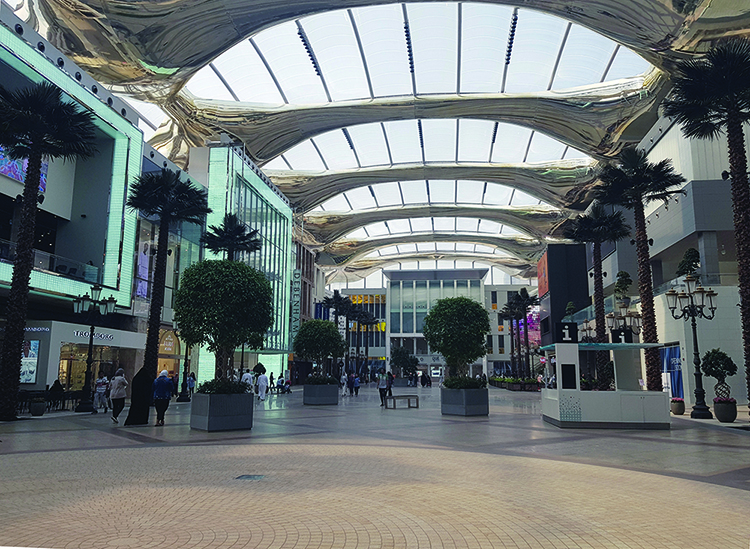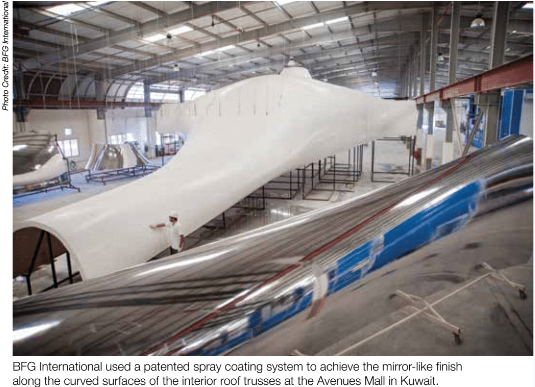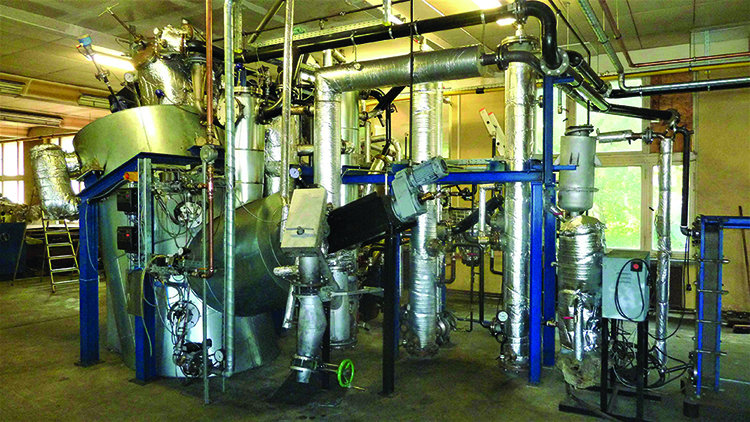

FRP’s Future in Vertical Construction
Having proven their performance capabilities for decades, composites are gaining more traction in construction projects of all types. When it comes to vertical construction – all facets of construction of residential and nonresidential buildings, including sitework – FRP is making a splash in landmark projects around the world.
“I’ve been in this field for a while,” says Samer Aljishi, president of BFG International, a composite design, engineering and manufacturing company. “And I’ve seen major architectural firms really becoming knowledgeable in composites, starting to work in it, to specify it, and this is accelerating.”
However, Aljishi, who is based in the island nation Bahrain, acknowledges that this acceptance moves at varying speeds in different parts of the world. He sees use of FRP growing in Scandinavian countries, and companies in the Middle East continue to specify the material in unique applications. In the United States, he finds, “The knowledge base and the use of composites in architecture is quite weak, and the number of firms serving the market are quite small … . In the Far East and Europe, it’s a nascent market that’s starting to grow.”
Design technology has driven FRP use in large-scale projects. With the growing movement from 2D CAD design tools to digital modeling, and the new possibilities that come through parametric design, architects are increasingly exploring curved building envelopes and uniquely shaped façades on building exteriors. “A lot of these projects can’t really be done cost-effectively or even technically with any other material,” Aljishi says.
These landmark projects, as well as smaller installations ranging from decorative interior wall panels to exterior millwork, have served an important role in proving FRP’s durability. They’ve also helped grow the available science and research body around FRP’s capabilities in vertical construction applications. Now, these time-tested applications are pushing at the last obstacles barring broader use of FRP in a range of vertical construction applications.

FRP Panels Get Competitive
While EDON Composites in Horsham, Pa., has been manufacturing ornamental architectural elements out of FRP since 1963, the company has recently seen greater interest from architects around incorporating fiberglass into panel systems. EDON completed two large façade jobs in the last year and is beginning work on several others.
“You go through peaks and valleys with different changes of building style,” says Matt Axel, president of EDON Composites. “We will always be doing the classical architecture – the cornices and columns and things like that – but, every once in a while, you see a push to a different style.”
Being able to create something different is pushing more designers to consider FRP, but the material’s other advantages are sealing the deal. In addition to easy customization, the light weight of composites is increasingly seen as an advantage for architectural applications.
For example, EDON is working with an architect on the early stages of a design for a new parking garage at the Hospital of the University of Pennsylvania. The façade will feature approximately 35,000 square feet of GFRP panels with elliptical cutouts. “The idea was to make a panel that you could rotate to get different design patterns with the molded holes, but reduce the tooling required,” says Axel. The panels, which will measure 2 x 2 feet and 4 x 4 feet, will be rotated at regular intervals around the building. In addition to their aesthetic appeal, the molded cutouts will allow air flow through the parking garage, which eliminates the need for a full sprinkler system in the building.
By molding the openings, rather than cutting them out after fabrication, the panels gain strength, says Axel. “With composites like ours, any type of bend or radius increases the strength in the part,” he explains. However, the light weight of the FRP panel – approximately 1½ to 2 pounds per square foot versus traditional materials that might weigh 7 to 8 pounds per square foot – cuts down on the need for extensive framing to support the façade. Using less framing, in turn, can bring down the total project cost.
“Composites actually can help to reduce cost when they are considered holistically from the beginning,” Axel says. This holistic overview also should account for the lifecycle cost of maintenance over time. Taken together, composites’ light weight and durability make a competitive cost argument.
“We have seen that on almost all the landmark projects that we’ve bid,” says Aljishi. “Whenever we’ve gone head-to-head with some of the more traditional materials, like glass-reinforced concrete or high-performance concrete, we’ve been able to compete on price quite well.”
These days, building owners and architects are more readily accounting for total lifecycle information, but for composites fabricators to capitalize on this new mindset, they must get their products on designers’ drawing boards early. That strategy is working well for EDON. “We’re reaching out to architects and saying, ‘Hey, we’re here. We can do this and make it look like this for you at a fraction of the cost or add things that you can’t do with metal,’” Axel says.
Aesthetic Appeal
As designers become more aware of FRP as a façade option, they’re exploring more than just unique shapes. “Another area where BFG spends a lot of effort is in creating particular finishes,” Aljishi says. Designers may be willing to accept FRP’s unique characteristics, but many want traditional stone or glass-like finishes. These finishes can be difficult to achieve, particularly when it comes to ensuring durability to a complex post-applied finish that matches the lifetime expectations of the composite material.
By way of example, Aljishi points to the chrome-like finish required for the FRP panels installed within the Avenues Mall in Kuwait, completed in 2017. Walkways throughout the large retail center are topped by a series of 192 highly reflective composite panels affixed to the inside of the roof structure’s main trusses.

BFG manufactured these FRP PET foam sandwich panels using CNC tooling and an open mold hand lay-up process. When assembled, the 14 full-size cowlings measured approximately 85 x 39 feet. The real challenge, however, was achieving the mirrored finish. A metal solution was ruled out as being too costly and heavy to suspend. That pushed the designer to consider FRP.
BFG’s process development team, in conjunction with a U.S.-based specialty coating technology provider, finished the FRP panels with a patented spray coating system. The resulting gleaming panels are fire resistant to BS 476-7 Class 2, the British surface spread flame test.
Structural Reinforcement
While FRP panels serve a largely decorative purpose in many vertical construction projects, structural use of FRP has been more limited. Some fabricators are exploring ways to boost the structural properties of panels. Bill Kreysler, president of custom FRP engineering and fabrication firm Kreysler & Associates in American Canyon, Calif., has spearheaded numerous innovative projects in vertical construction, including 1,500 uniquely-shaped GFRP panels for the façade of the Lucas Museum of Narrative Art under construction in Los Angeles. “We’re currently working on a weatherproof wall panel [for another project] so FRP could be used as the building envelope as well as the decorative skin,” he says.
One area where FRP is more likely to see an uptick as a structural material is in use as a reinforcement in concrete foundations and masonry structures. Concrete, which has relatively low tensile strength, is typically reinforced with steel rebar to add greater strength for thinner, longer, less-supported slabs. However, as billions of dollars’ worth of crumbling infrastructure across the United States indicates, steel reinforcement has problems. Chief among these is corrosion. Although concrete may offer some natural corrosion protection, this wears down over time.
Corrosion resistance, of course, is one area where GFRP products shine. While the higher upfront costs of GFRP have delayed its widespread use, research and innovation in these areas are driving some of the changes that may soon open the vertical construction industry to greater use of GFRP-reinforced concrete.
The American Concrete Institute (ACI) Technical Committee 440 develops guides and standards for FRP Reinforcement, including ACI 440.1R-15, Guide for the Design and Construction of Structural Concrete Reinforced with Fiber-Reinforced Polymer Bars. “The 1R document is recognized not only in North America, but throughout the world as the document at the basis of this technology in vertical construction,” says Antonio Nanni, a professor of civil, architectural and environmental engineering at the University of Miami.
Four years ago, the ACI Technical Committee opted to not revise the document and instead embarked upon the lengthy process of developing a code that lays out mandatory language for how to appropriately design and build using FRP-reinforced concrete for structural applications. Upon its publication in 2022, the document – tentatively titled Code Requirements for Structural Concrete Reinforced with FRP Bars and Commentary – would be referenced by ACI 318, Building Code Requirements for Structural Concrete, the basis for the design of every reinforced concrete building in the country. Through the new code’s reference in ACI 318, it would become incorporated into the International Building Code (IBC).
Since ACI 440.1R was last updated in 2015, a lot has changed in understanding the science behind FRP in these applications, and the committee has worked through these advancements. Nanni notes that some of the safety factors have been relaxed due to greater awareness of material properties. For example, he points to growth in knowledge around creep rupture.

“Composites have a peculiar behavior when subject to sustained load,” Nanni explains. “They suffer static fatigue.” Creep rupture describes the material’s failure over time after sustaining constant uniaxial loading. ACI 440.1R-15 sets the coefficient for ensuring that this creep rupture does not occur at 0.2, or 20% of the FRP’s strength under immediate load. However, that number was derived in 2001 using limited test data and few standards around the materials or test methods.
“Today, we can safely say it’s 30%,” Nanni says, adding that some data indicates this number could rise considerably higher in the future. “This is very significant, in that we have made the use of composites more competitive with respect to steel. Not because we look at saving money necessarily – although that is one outcome – but because we have better science to address these issues.”
Code Challenges
For many firms, the larger challenge is meeting established fire performance requirements. Jesse Beitel, senior scientist and principal with specialty engineer Jensen Hughes, was part of the team that developed the first code requirements on FRP for the 2009 edition of the International Building Code. (In the 2018 edition of the IBC, this information is found in Chapter 26, Section 2613). The code development group was tasked with establishing requirements for decorative finishes based on existing code requirements, but faced new territory in adding the capability to use FRP on building exterior.
The committee ultimately determined that limited amounts of FRP, such as in cornices or millwork that make up less than 20% of the wall surface, would need to pass an ASTM E84 fire test. It’s a test that many of today’s FRP products can pass, says Beitel. However, he adds, “If you want to build an exterior wall and you want to use FRP as the wall covering and it’s more than [20%], you need to meet NFPA 285, Standard Fire Test Method for Evaluation of Fire Propagation Characteristics of Exterior Wall Assemblies Containing Combustible Components. That test is typically where FRP has a problem.”
Aljishi agrees that meeting this code is an area where companies worldwide continue to struggle. “The need to meet the code limits the number of firms [working with FRP] to the very few who have the competence and knowhow, particularly in fire codes,” he says.
He adds that the codes are critical in limiting damage as well as broadening use of FRP. “It’s an ever-evolving area of study for anybody who is looking at the field because the codes are always changing, and any time there’s a major fire like the one in London you get another type of code,” Aljishi says. The Grenfell Tower apartment fires to which he refers killed 71 Londoners in 2017 due to the rapid spread of the fire, attributed in part to the use of aluminum composite panels for cladding. Aljishi adds, “Even if you didn’t have a code, insurers are asking for their own code, which drives the field toward noncombustible materials.”
Leading firms work to meet U.S. codes and similarly stringent codes for the protection it affords architects and composite fabricators alike. “I hear a lot from the United States that Middle Eastern companies are like ‘cowboys,’” Aljishi says. “This is inaccurate. Here in the Middle East, it depends on the project, but they normally follow either ASTM or U.S. building code, European EN standards or British standards. The large landmark projects have very stringent norms that work here as they work in the U.S.”
Still, these norms are tough to meet, and it’s this challenge that Beitel predicts will keep FRP confined to small portions of façades for the foreseeable future. “[The industry has] got to do a lot of work with respect to formulations and doing the testing to verify that this works,” he says.
Innovation Strategies
Nanni notes that the existing codes aren’t meant to deter use of FRP in any application. “Chapter 1 Section 11 of IBC says that the intention of the model code is not to prevent innovation,” he says. “So if there is a technology that is being tested according to a set accepted criteria, and that technology shows compliance with intent of this code through an evaluation service report, then the building official is compelled to adopt it – or you might say, should consider it.”
The International Code Council Evaluation Services (ICC-ES) works with innovators to publish acceptance criteria documents that outline new criteria or revisions to criteria. Those documents, once approved during open public hearings or public comment through icc-es.org, can be used to apply for an evaluation report. AC454, for example, lays out criteria for use of FRP Bars for Internal Reinforcement of Concrete Members and is used to issue ICC-ES evaluation reports to applicants, allowing use of new technologies in construction. “This is a methodology for deploying innovation without having to wait for code development that obviously takes years and is a very long process,” Nanni says.
Still, these types of exceptions are most helpful for large-scale landmark projects. Making FRP as common a structural product as wood or steel will take easily accessible guidelines. “The next step is to get FRP written into the structural codes,” Kreysler says. “I always hear how expensive and hard this would be, but all we need is a definition of structural FRP. Simply being recognized as a material is half the battle. The next step is to define the properties.”
Getting FRP incorporated into building codes – and gaining public buy-in surrounding composite materials in vertical construction – gets a little bit easier with every new project in which composites play a role. “It’s a matter of getting contractors familiar with the material,” Nanni says. “It takes education.”

SUBSCRIBE TO CM MAGAZINE
Composites Manufacturing Magazine is the official publication of the American Composites Manufacturers Association. Subscribe to get a free annual subscription to Composites Manufacturing Magazine and receive composites industry insights you can’t get anywhere else.





